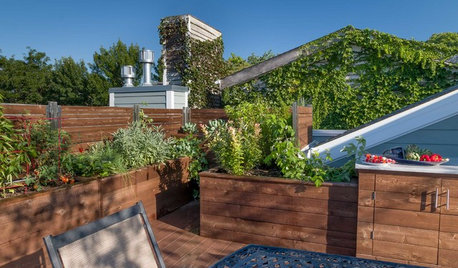Cardboard Mulching
dev_garden
10 years ago
Related Stories

GARDENING GUIDESNew Ways to Think About All That Mulch in the Garden
Before you go making a mountain out of a mulch hill, learn the facts about what your plants and soil really want
Full Story
GARDENING GUIDESGarden Myths to Debunk as You Dig This Fall and Rest Over Winter
Termites hate wood mulch, don’t amend soil for trees, avoid gravel in planters — and more nuggets of garden wisdom
Full Story
GREAT HOME PROJECTSHow to Replace Your Lawn With a Garden
New project for a new year: Lose the turfgrass for energy savings, wildlife friendliness and lower maintenance
Full Story
FRONT YARD IDEASBefore and After: Front Lawn to Prairie Garden
How they did it: Homeowners create a plan, stick to it and keep the neighbors (and wildlife) in mind
Full Story
GARDENING GUIDES10 Tips for Beginning Gardeners
With a simple sketch, basic tools and the right plants, you’ll be on your way to growing your first flowers or edibles
Full Story
GARDENING GUIDES7 Ecofriendly Gardening Ideas That Also Cut Chore Time
Spend less time weeding, less money watering and more moments just sitting back and enjoying your healthy garden
Full Story
GARDENING GUIDESLush, Foodie Abundance in a Small Urban Garden
This modest backyard garden provides its owner with fruit and vegetables all year round, thanks to an innovative low-maintenance approach
Full Story
EARTH DAY5 Ideas for a More Earth-Friendly Garden
Consider increasing the size of garden beds, filtering rainwater and using plants to reduce energy use
Full Story
FALL GARDENING5 Ways to Put Fall Leaves to Work in Your Garden
Improve your soil and yard the organic way with a valuable garden booster that grows on trees
Full Story
GARDENING GUIDESHow to Switch to an Organic Landscape Plan
Ditch the chemicals for a naturally beautiful lawn and garden, using living fertilizers and other nontoxic treatments
Full StoryMore Discussions






Kimmsr
digdirt2
Related Professionals
Eden Prairie Landscape Architects & Landscape Designers · Mountain Brook Landscape Architects & Landscape Designers · Dinuba Landscape Contractors · Federal Way Landscape Contractors · Framingham Landscape Contractors · New Braunfels Landscape Contractors · Overland Park Landscape Contractors · Parker Landscape Contractors · Royal Oak Landscape Contractors · Seymour Landscape Contractors · Snoqualmie Landscape Contractors · West Covina Landscape Contractors · York Landscape Contractors · Braintree Decks, Patios & Outdoor Enclosures · Truckee Decks, Patios & Outdoor Enclosuresnaturewest
jbraun_gw
dev_gardenOriginal Author
digdirt2
Kimmsr
alisande
clayfarmer
alisande
cold_weather_is_evil
alisande
dev_gardenOriginal Author
gardenper
lov2garden
lazy_gardens
ju1234
Kimmsr
lov2garden
renais1
alisande
lazy_gardens
Kimmsr
lov2garden
MsSharon
Kimmsr
lov2garden
bossyvossy
dev_gardenOriginal Author
Bromus